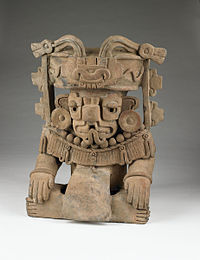Cocijo
Cocijo[
Cocijo was the most important deity among the pre-Columbian Zapotecs because of his association with rainfall.[2][3] He is commonly represented on ceramics from the Zapotec area, from the Middle Preclassic right through to the Terminal Classic.[1] Cocijo was said to be the great lightning god and creator of the world.[4] In Zapotec myth, he made the sun, moon, stars, seasons, land, mountains, rivers, plants and animals, and day and night by exhaling and creating everything from his breath.[4]
Appearance
In Zapotec art Cocijo is represented with a
Representations of Cocijo combine elements earth-jaguar and sky-serpent, which are associated with fertility. His eyebrows depict the heavens, his lower lids represent clouds, and his forked serpent's tongue represents a bolt of lightning.[3]

Classic Period
At the Late Classic Zapotec archaeological site of Lambityeco in Oaxaca, the stucco busts of Cocijo are depicted holding a jar spilling water in one hand and bolts of lightning in the other.[5] During the Classic Period the jaguar was associated, at least partly, with Cocijo.[6]
Postclassic Period
Among the Zapotecs of the
Colonial Period
The worship of Cocijo continued into early Colonial times. In the late 1540s, three community leaders of Yanhuitlán were accused of making sacrifices to the deity, including human sacrifices, by the inhabitants of hostile neighbouring villages and were tried by the inquisitor Francisco Tello de Sandoval.[8]
Notes
References
- Adams, Richard E.W. (1996). Prehistoric Mesoamerica (Revised ed.). Norman: OCLC 22593466.
- Avila Aldapa, Rosa Mayra (2002). Los pueblos mesoamericanos (PDF) (in Spanish). OCLC 57024647. Archived from the original(PDF) on 2009-06-12. Retrieved 2009-02-18.
- Greenleaf, Richard E. (January 1994). "Persistence of Native Values: The Inquisition and the Indians of Colonial Mexico". The Americas. 50 (3). S2CID 147422898.
- Marcus, Joyce (October 1978). "Archaeology and Religion: A Comparison of the Zapotec and Maya". World Archaeology. 10 (2). Taylor & Francis, Ltd.: 172–191. .
- OCLC 28801551.
- Read, Kay Almere; Jason González (2000). Handbook of Mesoamerican Mythology. Oxford: OCLC 43879188.
- Urcid, Javier (2005). "Zapotec Writing: Knowledge, power, and memory in ancient Oaxaca" (PDF). Foundation for the Advancement of Mesoamerican Studies, Inc. (FAMSI). Archived (PDF) from the original on 2006-02-24. Retrieved 2009-02-18.
